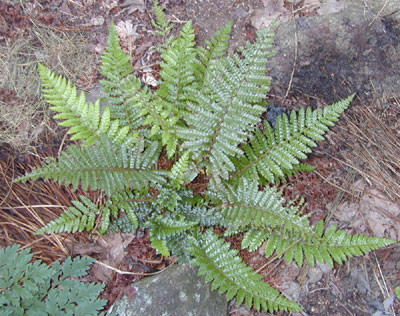| Polystichum polyblepharum | ||
Japanese tassel fern, bristle fern | ||
|
Etymology
From poly. many, + blepharum, fringed like an eyelash
Description
Rhizome: erect, short, massive, scaly.
Frond: 100 cm high by 25 cm wide, evergreen, monomorphic , blade/stipe ratio: 4:1. Stipe: grooved, tan, darker at base, green only near the tip of the frond; old stipes persistent, densely scaly throughout; larger scales at base of stipes narrowly lanceolate to broadly so, light brown to reddish brown, about 2 cm long, vascular bundles: 4 or more, in an arc. Blade: 2-pinnate, ovate, acute at apex, glossy, papery, scales on rachis narrower upwards, nearly hair-like on uppermost part, fibrous-like scales on lower surface. Pinnae: 15 to 25 pair, 15-25 mm wide, lower pinnae bending forward, the lowest most, in some specimens 90�, overlapping, also bending downwards; pinnules eared, upper one prominent, spine-tipped; costae grooved above, discontinuous with the rachis; veins free, forked. Sori: round, medial, between midrib and margin, indusium: peltate, papery, white, shriveling, central, sporangia: tan, then brown. Dimensionality: lower pinnae bending forward, the lowest most, in some specimens 90�, overlapping, also bending downwards. Culture
Habitat: floor of light forests, slopes, grasslands.
Distribution: Japan, southern Korea, eastern China.
Hardy to -25�C, USDA Zone 5.
Distinctive Characteristics
in unfurling the tip of the frond droops, tassel-like, giving rise to the common name: see the photo labeled 'specimen' above
Synonyms
Aspidium polyblepharum Roem. ex Kunze Polystichum japonicum (Franch. et Sav.) Diels Aspidium aculeatum (L.) Schott var. japonicum Franch. et Sav. Aetopteron polyblepharon (Roem. ex Kunze) Nakai |
|
|
